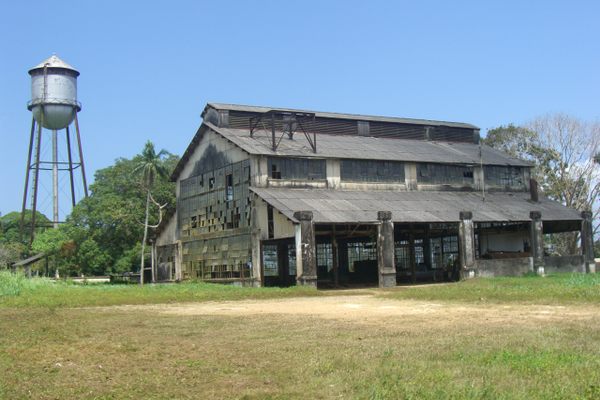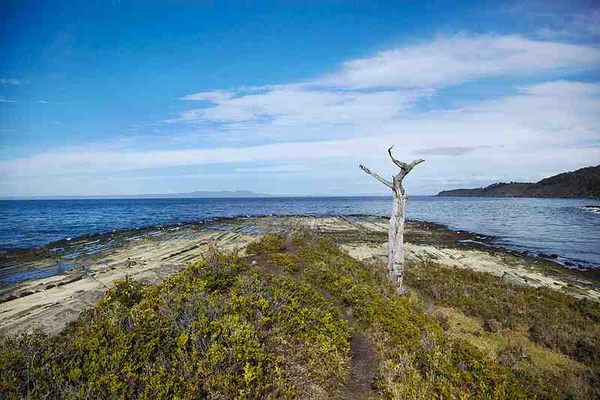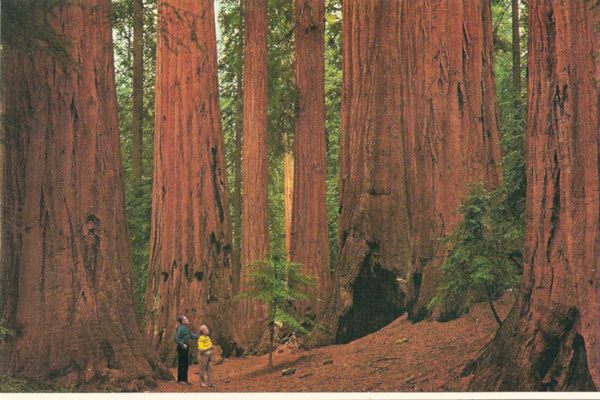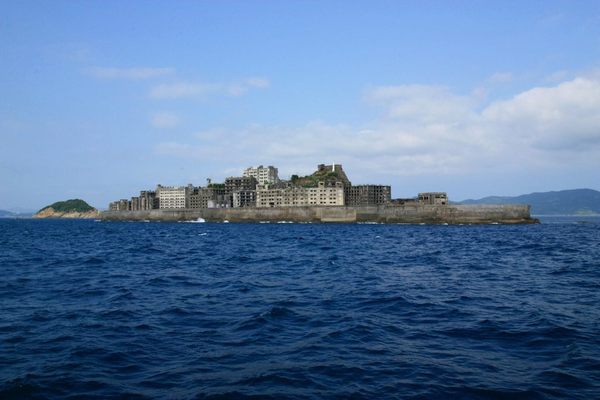Essential Guide to Monuments of Epic Failure
Design for a Victorian Tower of Babel - complete with a steam-powered railway (via Archive.org)
Failure, by its nature, tends not to leave traces. Buildings are demolished. Books disappear into landfill. Manuscripts are written over. Statues are smashed to pieces. The world goes about its business, swiftly forgetting.
But some failures are too big to disappear quietly. They stick around — for years, sometimes for centuries. The six monuments below are born of truly epic failure. They are the spirit of Ozymandias in concrete — ambitions which paid no attention to reality.
KONGRESSHALLE
Nuremberg, Germany
The Kongresshalle (via Nicohofmann/Wikimedia)
The half-finished Kongresshalle looms over Nuremberg like a sinister Nazi Colosseum — which is exactly what it is. Nuremberg, scene of Leni Riefenstahl’s epic propaganda film Triumph of the Will, was the Nazi party’s stage: a backdrop for rallies, parades, and indoctrination — and for the creation of chilling images of German power. The Nazi rally grounds covered 11 square kilometers (118,404,000 square feet) of unforgiving concrete and granite. At their heart was the Kongresshalle, a gigantic congress center.
Groundbreaking ceremony for the Kongresshalle (via Wikimedia)
Designed by Franz and Ludwig Ruff, construction began in 1935, with Hilter attending the groundbreaking ceremony. It was built on a vast scale: the completed Kongresshalle would have seated 50,000. Its colonnades and layers of archways were designed to echo the Colosseum in Rome — another symbol of an empire triumphant. Fascist architecture, in both Germany and Italy, drew heavily on themes from ancient Rome — Mussolini was continually photographed in front of ancient monuments looking unconvincingly pensive, seeking to portray himself as a second Augustus. Hilter’s architects saw in the ancient world the blueprints for their leader’s fantasy of a thousand-year Reich.
photograph by Ben Garrett
The Second World War diverted attention away from the Kongresshalle’s construction, and it was never completed. Despite its monumental scale today, it only ever reached around half of its planned height. With the fall of Hitler’s regime, the rally grounds of Nuremberg were abandoned, for a time. Later German governments elected to preserve them, to prevent the memory of past insanities from slipping away. The Kongresshalle was landmarked in its half-built state. Today, it can be visited along with the remains of the Nuremberg rally grounds — and all can be thankful that it remains only a monument to failure.
photograph by Theresa Meier
THE WATKIN TOWER
Wembley, London, England
Winning design for the Watkin Tower (via Public Domain Review/Flickr)
One of the most remarkable buildings in Victorian London was never completed, and has subsequently been forgotten almost completely.
On the outskirts of London in 1893, a gigantic tower was under construction near Wembley. It was championed by one of the country’s richest men, and set to outdo the Eiffel Tower in Paris. Workmen were digging out enormous foundations, and eager reports were filling the newspapers every week.
Vanity Fair caricature of Sir Edward Watkin (via Wikimedia)
Sir Edward Watkin, one of Victorian Britain’s most colourful rail tycoons, wanted more passengers for his new Metropolitan railway line, which led to Wembley. He also wanted to put the Parisians in the shade. His supersized tower offered a chance to do both. Plans were swiftly drawn up. “In another eighteen months,” Freeman’s Journal wrote in 1892, “London will rejoice in a New Tower of Babel, piercing the skies some 150 feet higher than the renowned Eiffel Tower of Paris. Not only will the Watkin Tower look down 150 feet on the Eiffel Tower, but it will be capable of taking up three times as many passengers at a time.”
The design was selected after a widely-advertised public competition: many of the early designs embraced Babel’s sense of limitless possibility, and the collected competition entries are a treasure-trove of high Victorian lunacy, a flip-book of blueprints for a Steampunk London that never was. A railway winds its way up the side of one tower. Another contains a replica of the Great Pyramid at Giza. Hanging gardens in the sky support a community of tower-dwelling vegetarians. Many simply mimic the Eiffel Tower — but with ostentatious extra floors.
Rejected design for the Watkin Tower (via Archive.org)
Soon, though, Watkin’s Babel began to run into trouble. Funds dried up, construction costs increased, and after work ceased with only the first level complete, malicious nicknames began to cluster around the project. “The London Stump,” said some. “Watkin’s Folly,” said others. The squat remains of the Watkin Tower sat rusting in Wembley Park until 1907, when dynamite, rather than divine wrath, put an end to them with little ceremony. Today, the tower’s traces are buried in the foundations of Wembley Stadium, with little to mark what was to have been one of the greatest buildings of the Victorian age.
The abandoned remains of the Watkin Tower (via Public Domain Review/Flickr)
NEW SOUTH CHINA MALL
Dongguan, China
A replica of the Arc de Triomphe greets shoppers at the New South China Mall (via Wikimedia)
Greed, and what the ancient Greeks called hubris — the kind of pride and confidence which it is dangerous for mere mortals to have — drove more than a few of the structures on this list. Watkin was already rich, and already a national figure, but he wanted more money, and more celebrity.
Such, too, was the dream of Alex Hu, China’s billionaire instant-noodle king. He was going to build a monument that would put his hometown, Dongguan, on the map — and make him into a national hero. This being 21st century China, he would build not a tower, or a giant assembly-hall, but a shopping mall. The biggest shopping mall the world had ever seen.
Map of the New South China Mall, as it was intended to be (via Wikimedia)
Dongguan lies at the smoggy heart of the new Chinese Dream, in the Pearl River Delta: a sprawl of factories, highways, and concrete, running inland from Hong Kong. Here, in 2005, the New South China Mall opened. A replica Arc de Triomphe welcomes shoppers; a Venetian canal snakes for 2 kilometers (1.24 miles) through the complex; a gigantic indoor roller coaster loops above the walkways. Altogether, there is space for some 2,350 shops. Newsweek called it one of the “new wonders of the world.” The developers told the New York Times: “We wanted to leave our mark on history.”
Empty shops stretch into the distance at the New South China Mall (via Wikimedia)
But the shops — and the shoppers — never came. What Hu hadn’t considered was the location: all this was built on a former farm, miles from the centre of Dongguan, with almost non-existent public transport links. Retailers took one look at it and stayed away. Other than a few fast food chains, the gigantic complex is almost entirely deserted.
A cleaner at work amidst the empty shops in the New South China Mall (via Remko Tanis/Flickr)
Now, with vacancy rates still running at 99% according to one recent article, the mall is an eerie ghost city: empty shop fronts stretch into the distance, cordoned-off escalators lie dormant, and cleaners still polish the glass and chrome — but no-one is there to see it. It is all the more disconcerting because of the booming landscape that surrounds it.
FORDLÂNDIA
Brazil
Ruins of Fordlândia (via Wikimedia)
Alex Hu and Sir Edward Watkin may seem like rather ambitious men, prone to rather grand schemes, but they have nothing on Henry Ford. One day, Ford decided that he wanted to build a town in the middle of the Amazon rainforest. Fordlândia, Brazil, was born.
During the 1920s, with car production expanding rapidly, Ford found himself paying more and more heavily for rubber for his tires. The only rubber plantations which could supply him were located in East Asia, and were under the control of European powers. In 1927, he decided to do something about it: he would carve out a new rubber plantation in Brazil to supply his factories, and he would build a miniature American town in the middle of the jungle, for his workers and managers to live in. Ford was the richest man in the world. A town was small potatoes.
A dentist’s chair in the ruins of the hospital at Fordlândia (photograph by Guido Otero)
As Greg Grandin puts it in his recent book on the failed enterprise, this was to be an example “of how Ford-style capitalism — high wages, humane benefits and moral improvement — could bring prosperity to a benighted land.”
Fordlândia was, from day one, a disaster. The site was almost impossibly remote — 18 hours’ journey by riverboat from the nearest town, and 600 miles from the Atlantic. Ford’s handpicked managers, as Grandin notes, did not include “a horticulturalist, agronomist, botanist, microbiologist, entomologist or any other person who might know something about jungle rubber and its enemies.”
The town in 1933 (via The Henry Ford Museum)
“Ford-style capitalism” did not translate successfully. Compulsory poetry readings and square-dances — and a ban on alcohol — went down like a bad joke. Workers began to riot with increasing frequency, destroying cars, trucks, buildings, tractors, and the loathed time-clocks. Ford’s manager, Einar Oxholm, sat morosely on the porch of his house, sipping rum.
A Scot, Johnson, dispatched upriver to source rubber seeds, went entirely mad, and ran through the villages chasing goats and chickens with a bottle of perfume, yelling: “Mr. Ford has lots of money; you might as well smell good too.” One American, after quietly assessing all of his options, jumped headlong into a nest of crocodiles.
Fordlândia’s time-clock, destroyed by rioters in December 1930 (via The Henry Ford Museum)
Needless to say, Fordlândia never came close to achieving Henry Ford’s ambitions. The rubber trees died. The workers drifted away. Despite numerous promises to visit, he himself never set eyes on the place. In November 1945, Ford’s managers simply packed up and left, abandoning Fordlândia to the elements. Many of the model Midwestern houses still stand, encrusted with bat guano and hidden behind overgrown gardens. A rusting 150-foot-tall water tower looms over the trees. And the journey from the nearest town still takes 18 hours.
PORT FAMINE
Patagonia, Chile
Site of Port Famine, Chile (via Wikimedia)
Ghost towns like Fordlândia dot the globe — from the abandoned island of Gunkanjima, Japan, to the homes of Chernobyl’s workers in Pripyat, Ukraine, and the dust of Terlingua, Texas. All have melancholy histories. But few are as terrible as that of Port Famine in Chile.
The town lies in Patagonia on the north shore of the Strait of Magellan. It is a bleak, cold, astonishing place, more fit for sea lions than humans. Here, in 1584, Captain Pedro Sarmiento de Gamboa founded a new city: the City of King Philip, or Ciudad del Rey Don Felipe. 337 settlers – including women, children, and two Franciscan priests – were to claim this corner of the world for Spain, with little more than hope and a gigantic wooden crucifix to sustain them.
The odds were always against them. Few of the settlers understood how to grow food in such conditions, or knew what lay in wait for them in the harsh seasons of the year. Illness, rodents, bitter cold, and crop failure: one after the other struck the settlement. When Thomas Cavendish, a British privateer, came upon the settlement some years later, not a single one of the original inhabitants was left alive. Graves dotted the landscape. The buildings were already falling into ruin. Cavendish renamed the place Port Famine, or Puerto del Hambre — and the name has stuck.
1846 illustration of Port Famine, or Puerto del Hambre (via Wikimedia)
No significant attempts were made to resettle Port Famine until the 1840s, though early in the 19th century, some British ships used it as a base. It remained very much a place of ill omen. When HMS Beagle visited in August 1828, her captain, Pringle Stokes, shot himself dead, driven to despair by the harsh conditions. The Beagle returned some years later, with Charles Darwin aboard — who appears to have been impervious to the place’s reputation – and today, a trickle of tourists come to see what remains of the City of King Philip: the ruins of a church, and a handful of graves, sloping down towards the sea.
THE SNOW TOMB OF CAPTAIN ROBERT FALCON SCOTT
Ross Ice Shelf, Antarctica
The grave of Scott, Henry Bowers, and Edmund Wilson (via Wikimedia)
Intensely personal stories lie at the heart of many of these places. While failure can sometimes – as in the case of Hitler’s Kongresshalle – be a cause for celebration, more often there is heartbreak behind it. So it was in November 1912, on the Ross Ice Shelf in Antarctica.
There a British expedition was searching for Robert Falcon Scott and his party, who had vanished into the snows the previous year, never returning from their search for the South Pole. On November 12, one of the group, Charles Wright, saw “a small object projecting above the surface” of the ice. It was part of a tent. They had discovered the final resting place of Scott and two of his men, Henry Bowers and Edward Wilson.
Scott and members of his expedition (via Wikimedia)
Scott lay between the others — his diary recording their final days: “It seems a pity, but I do not think I can write more,” the last entry ran. “For God’s sake look after our people.” They had died just 11 miles short of a food depot — but 11 miles, in an Antarctic blizzard and -60C temperatures, was close to an eternity. While they had reached the South Pole, they were not the first to do so: Roald Amundsen’s competing expedition had got there first, five weeks ahead of Scott. Turning back, Scott knew that his expedition had not succeeded.
Why it was that Scott and his men perished has been debated ever since, with some scholars pinning at least part of the blame on Scott’s decision-making, while others point to a series of misfortunes, coupled with unforeseeable weather. The search party themselves were subject to almost impossible conditions: one of them, Apsley Cherry-Garrard, recalled his teeth chattering so violently that they shattered.
Captain Robert Falcon Scott (via Wikimedia)
The bodies were not brought back to Britain. Instead, wrote Cherry-Garrard, “We never moved them. We took the bamboos of the tent away and the tent itself covered them. Over them we built the cairn.” They left this cairn of stones, topped with a solitary cross, standing in the middle of the Antarctic wasteland: a memorial to the impossible bravery of Scott’s ill-fated expedition. It has stood there ever since — gradually covered with year after year of fresh snowfall. By now, the grave has long since been buried deep under the ice. It is likely that eventually, encased deep within an iceberg, the bodies of Scott, Bowers, and Wilson will slowly drift away, out to sea — leaving no monument behind.
MONUMENTS TO EPIC FAILURE:
KONGRESSHALLE, Nuremberg, Germany
THE WATKIN TOWER, Wembley, London, England
NEW SOUTH CHINA MALL, Dongguan, China
FORDLÂNDIA, Brazil
PORT FAMINE, Patagonia, Chile
THE SNOW TOMB OF CAPTAIN ROBERT FALCON SCOTT, Ross Ice Shelf, Antarctica






















Follow us on Twitter to get the latest on the world's hidden wonders.
Like us on Facebook to get the latest on the world's hidden wonders.
Follow us on Twitter Like us on Facebook